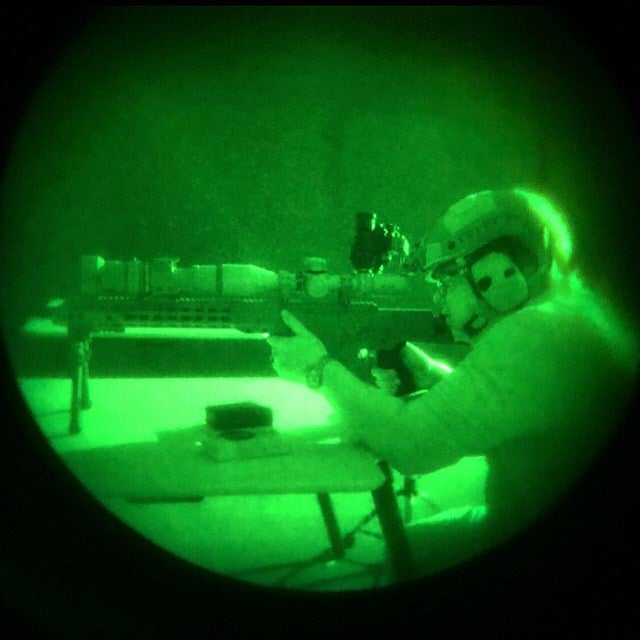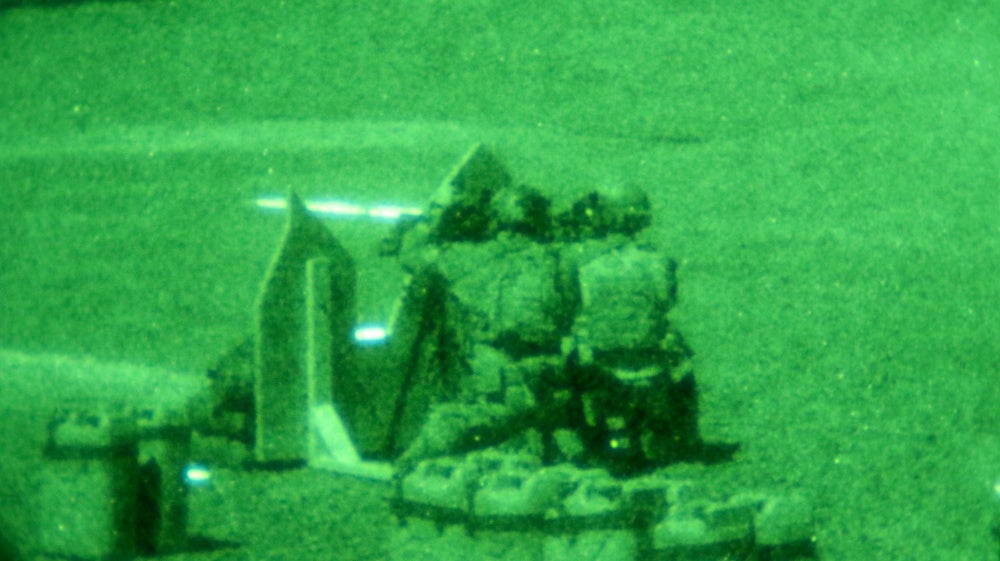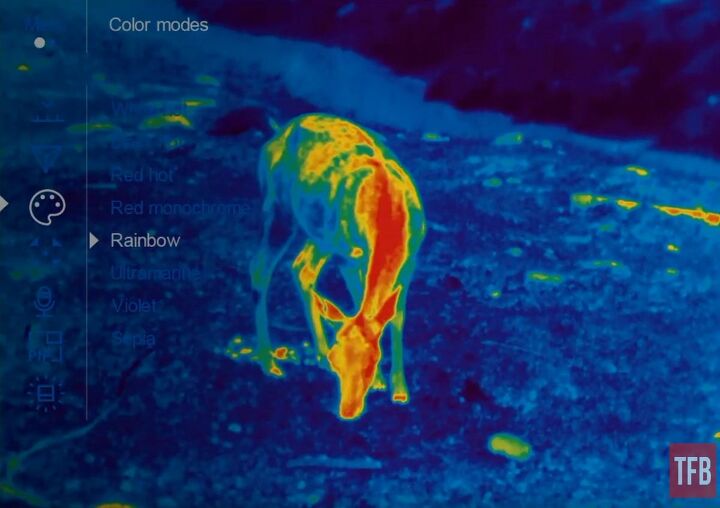The electromagnetic (EM) spectrum ranges from gamma rays to long radio waves. In this wide spectrum resides the visible band of violet to red light. All the EM spectrum travels at the speed of light: 300,000,000 meters/second (186,411 miles/second). A good rule of thumb is that light travels about one foot in one nanosecond or a billionth of a second. This spectrum is divided into different wavebands: gamma rays, x-rays, ultraviolet, visible, infrared, short radio, and long radio wavelengths, arranged from the most energetic to the least. The higher the energy band, the higher the frequency or cycles per second and the shorter the physical distance between peaks of this cycle. We refer to a single cycle, of any of the EM spectrum, to be its wavelength. In the visible band, wavelength is the same as color.
What does this have to do with using a firearm you ask?
Quite a bit actually. If you have iron sights on your rifle, then you are using the visible band of light to see, identify and shoot your target. When it gets dark, it is hard to see your target. A rifle scope will provide magnification of this sight image and more visible light that can be collected by your eye. The larger the objective lens of your scope, the greater the light collected up to a point. Shooting that feral pig at dusk is greatly aided by a rifle scope. This covers the visible portion of the EM spectrum and is old news to most of us.
More on thermal from TFB
- TFB Review: Pulsar Helion 2 XP50 PRO Thermal Monocular
- Friday Night Lights: SIG Echo3 Thermal Reflex Sight
- TFB Review: Pulsar Helion 2 XP50 Thermal Monocular
What about other bands of light, you ask? How can we use them to our advantage? Good questions. Since your rifle would need a satellite dish-sized antenna to see short radio waves (microwaves), and it wouldn’t have sufficient resolution for aiming, that isn’t a practical solution. And really short wavelengths of the EM spectrum (gamma and x-rays) don’t travel well through the atmosphere and are harder/more expensive/more dangerous to implement, we won’t be using them either. Superman may have x-ray vision, but we haven’t quite made that a reality. But we can use the infrared band and as such; “night” sights are readily available.
Just like the EM spectrum can be broken up into wavebands, so can the infrared (IR) spectrum. Near-IR (close to visible), mid-wave IR, and longwave IR are the three bands we will consider. Generally speaking, what separates these sub-bands from their neighboring sub-bands are two great dividers. First, near-IR light behaves like visible light even though we can’t see it. Its imagers depend on a light source or reflected light such as starlight, moonlight, or an illuminator. Mid-wave and longwave IR behave differently from near-IR in that the wavelengths they “see” are differences in heat/temperature (more about that in a bit). Note: sunlight reflected off of a shiny surface can definitely be seen in the infrared wavebands, but this discussion is about “night” vision scopes. Secondly, the atmosphere separates near-IR from mid-wave from longwave IR. The atmosphere attenuates infrared light between these bands to the point of being unusable.
All rifle sights below (shorter wavelength) approximately 2.2 micrometers (2,200 nanometers) are looking at a source or reflected near-IR light. It used to be called “night vision” as, for example, “night vision goggles”. These rifle sights work very well if there is sufficient light from say a bright moon, or a clear night of stars (the really old term “starlight scope”). Image intensifier tubes are in this group. They take incoming near-IR light, convert those photons (light particles) to electrons and then multiply (intensify) their numbers. But if the weather is overcast with no moon, some near-IR imagers can have issues but this is largely reliant on the spec of the tube being used. The firearm optical industry has augmented near-IR imagers with an accompanying illuminator.
This illuminator will provide a beam of near-IR light, generally a diode or laser diode light source, that has a beam angle adjusted to be wider than the near-IR rifle sight. This is a pretty good system for the civilian hunter who likes to shoot pigs at night. This is a lousy system if you are in combat and your enemy can see your “invisible” illuminator with his inexpensive near-IR monocular; you are no surprise to him in that situation. It is worth noting that “Black Silicon”, a treatment for silicon imagers like CMOS (complementary metal-oxide semiconductor) or CCDs (charge-coupled device) developed by Sionyx, improves the absorption of near-IR light (more light absorbed means turning more photons into electrons). Sionyx imagers will also present a color image with very little light, a nice feature compared to the other near-IR imagers. Though each of the near-IR imagers require less reflected light (or a light source) than visible light systems, they still require this light.
As mentioned above, the difference between near-IR and both mid-wave and longwave is that near-IR requires reflected light while both mid-wave and longwave infrared collect emitted light; temperature differences or heat. The world around us and anything that has a temperature difference versus the background temperature can be viewed by emitted light. A warm hog on a cool night has quite a bit of thermal contrast (temperature difference) against its background. This would be “true” night vision.
More on night vision from TFB
- Friday Night Lights: Cheap Night Vision Upgrade – LLI White Phosphor Filter & DIY Tarsier Eclipse
- Friday Night Lights: Last Shadow – Helicopter Night Vision Shoot
- Friday Night Lights: ATN NVM14 – Entry Level Night Vision Monocular
I have never seen a rifle night sight that uses mid-wave IR (3.3-5.5 micrometers). These imagers are preferred by the U.S. Air Force and are used in their targeting pods. They are still very expensive. I will note that there are some new mid-wave imager technologies that may find their way onto our rifles, but it’s likely to be a few years until this happens.
The U.S. Army prefers the third band in the IR, 8-12 micrometers, or longwave IR. Tanks and helicopters use longwave IR imagers because the longer wavelength performs better through dust and smoke, important to ground forces. For decades, Mercury Cadmium Telluride (MCT) was the imager of choice. The major issue for using MCT was cooling; for this material to function well, the focal plane array (imager) must be at liquid nitrogen temperatures, approximately -320 deg. F. As you can imagine, a significant amount of funding went into developing cooling system for these imaging detector arrays.
Lately onto the scene are VOx (vanadium oxide where x is the ratio of V to O and generally between 1.5 and 2) microbolometers. These are room-temperature (uncooled) imagers that work in the 7.5-13.5 micrometers range, longwave IR. Microbolometers have been around for a while, but not this small and low-cost. These imagers are getting really inexpensive to make and there are multiple offerings available now, and the price will continue to decrease. You can purchase complete rifle imagers: infrared objective lens to eyepiece (which uses a small LED or LCD screen behind an eyepiece lens) and has a reticle internal to its optical path, or just the imager which fits in front of your existing rifle scope (still using the small LED or LCD screen). It is important to note that putting your imager behind your rifle scope is useless as the glass in your rifle scope will not transmit longwave IR. This can be seen in longwave IR videos shown on YouTube of people with opaque eyeglasses which don’t transmit longwave.
Nearly all longwave IR imagers will allow you to choose “white hot” or “black hot”. The white-hot setting will make your pig look “white” against a cool “blacker” setting and “black hot” is the opposite. I prefer white-hot imagery but to each his own. Additionally, your longwave IR imager can also be mapped in pseudo-color where a color map is spread across the cool to warm differences of the scene you are imaging. I hope this helps clarifies how various bands of light are used for hunting and observation.
This guest post was written by M. K. Flowers
 Your Privacy Choices
Your Privacy Choices



